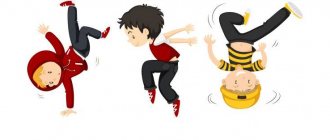In communication, a person constantly uses facial expressions and gestures, and some of them he does specifically to emphasize something, but the rest happens to him unconsciously, automatically. Human psychology deals with deciphering such information based on behavior and gestures, so that people can clearly understand the secret signals emanating from the interlocutor during a conversation.
According to research, a person conveys only 30% of all information using words. The rest is non-verbal communication, where body language is used.
Articles on the topic
- Social adaptation of convicts: specifics of the activities of special institutions 01/19/2022
- Intercultural adaptation is the basis for successful life abroad 01/17/2022
- Poor parenting and its impact on human behavior 08/24/2021
- What does a femme fatale mean and how does she differ from a bitch 06.24.2021
Unconscious movements that a person makes without any reporting in his head are a source of information; with its help, you can learn true information about the character of other people.
Facial expressions and body movements that can tell much more than words.
According to psychologists, up to 80% of communication is carried out through non-verbal means. Tone of voice, posture, involuntary movements of the eyes and facial muscles can tell much more about the mood and state of the interlocutor than the words spoken by him.
Today we will tell you about 15 body language signs that will help you better understand the people around you.
Non-verbal communication. Truth or myth?
Some doubt the existence of body language, considering all conversations on this topic to be empty fiction.
Opponents of the theory of postures and gestures argue that changes in body position occur for completely different reasons. For example, when sitting, it is more convenient for a person to cross his arms if there are no armrests, and not at all because he is a misanthrope.
People start yawning not only because they start to get bored. Lack of oxygen in a cramped office or overwork can trigger this process. Therefore, before formulating conclusions, it is necessary to understand why the interlocutor began to actively gesticulate or rotate an object in his hands.
An experiment will help reveal sign language. And the subjects can be friends and relatives, whose facial expressions, postures and gestures change in different life situations. But in no case should you impose and put pressure, otherwise you can damage many years of friendship and good relationships.
Wrinkle your nose
This is a clear sign that what you said does not meet with the approval of your interlocutor.
Perhaps he himself will not understand what exactly the problem is. see also
Body Language: 6 Advanced Tricks That Can Benefit Your Communication
Nonverbal Communication
Nonverbal communication is the process of transmitting thoughts without the use of speech - the second signaling system. It absorbs 60–80% of veiled information.
Each of us, when communicating with an opponent who competently sets out the essence of the matter and argues with facts, often feels some kind of catch in his words. But, despite the reliability and veracity of the information, intuition suggests that you should not rely entirely on this person. And with further communication, discomfort is felt, the person is looking for something to complain about.
And, indeed, the interlocutor is betrayed by changes in facial expressions, posture and gestures that contradict his smooth presentation. A certain inconsistency appears and serious concerns arise that he is not acting in your interests at all.
The ability to correctly read the secret language of gestures will help you avoid unpleasant situations. For example, HR specialists cannot do without knowledge about the hidden intentions of potential employees.
It is difficult for a person to hold back emotions for a long time; they must find a way out. But due to circumstances, rules of decency and norms of society, we are not free to surrender to the will of feelings and express them by changing posture, facial expressions and gestures. Often this behavior becomes the norm and turns into a habit.
To keep distance
Distance is another sign of our body language that can tell a lot about a person’s mood. That's why we don't like it when some people come too close, violating personal space. Especially if these people actively gesticulate. An emotional connection shows how close you are to someone. And in the absence of it, people try to stay as far away from each other as possible.
How to understand that a person likes you
Communicates with you as needed or frequently
If a relationship develops, then a person, as a rule, is looking for an opportunity to communicate. You can chat freely, share your thoughts and feelings, joke and ask each other questions.
But, if a person doesn't really like you, his answers will be very short.
.
He will only talk to you when necessary and will not try to maintain or continue the conversation.
During a conversation, he will often look to the side or at the phone. If you ask: “How are you?”, the person always answers “Fine” or “Good”, and in messages he immediately gets to the point and never starts with at least a friendly greeting.
Excessive friendliness
© Getty Images
An ill-wisher who needs something from you may, on the contrary, show a sweetly friendly disposition, always smile tensely and assent, trying to gain your trust.
It is quite difficult to immediately understand the true attitude of such a person. In this case, it is important to pay attention to other nonverbal signs and how he communicates with other people.
Physical contact
If you are on a date or just meeting a friend, pay attention to whether there is any physical contact between you.
We use touch when we are caring for someone, we want to be physically close, we feel emotionally comfortable.
When you sit next to each other or pass by, you can lightly touch each other. The person may simply place their hand on your shoulder or gently touch your arm. We don't usually do this with just anyone—mostly those we like.
If a person tries to contact you
, chances are he enjoys your company and wants to be closer to you.
Does he make plans?
You can laugh together and have a good time, but pay attention to the fact that he is always making plans
?
If you notice that you always text first, plan and carry on the conversation, this is not a good sign.
A person who likes you will usually try to take the initiative as well, even if it means it in different ways.
If, on the other hand, you see only a passive attitude, it means that the interlocutor is not so interested.
Is he listening to you or not?
© Getty Images
Your friend or well-wisher will value your thoughts and point of view and give you the opportunity to express your opinion
.
A person who doesn't like you or is indifferent to you probably won't care about such niceties.
If you are not listened to or given time to speak, it leads to a one-sided relationship and you are left feeling like you are not being heard.
Finds excuses
If sometimes things don't go according to plan, that's okay. But, if a person constantly cancels meetings, finds excuses why he cannot meet with you, this can be an important clue.
Of course, we are all busy, but people who like each other find time at least sometimes, and if they cancel the meeting, they try to make amends.
Awkward situations
When we are around those we truly like, everything seems easy and free.
But if your interactions often involve awkward silences or interactions seem awkward, this may be a sign that your friendship or crush isn't as strong as you think.
Sudden silence
If you observe a situation where people are actively discussing something and actively participating in the conversation, but suddenly become silent
, as soon as you enter, or try to change the topic, then this is not a very good sign.
Perhaps you are not well known yet and you are not part of a new group, or there are unflattering rumors about you and you have ill-wishers.
Look away
Many people think that when the interlocutor looks away, he is certainly lying. But sometimes this interruption of eye contact can be due to social, psychological and cultural differences. In some countries, looking into someone's eyes is a mere trifle, while in others, such as Arab countries, it is a rude gesture.
If you are in front of an introvert, he may also avoid eye contact simply because he is uncomfortable. Therefore, it is better to monitor the movements of the muscles around the eyes. If the person in front of you is nervous, uncomfortable or stressed, their muscles will also be tense.
Photo: open Internet sources
Human psychology by behavior and gestures
The look and face are the first things a person encounters when communicating. Eyes are a reflection of a person’s internal state. Because of this, the view may be different. When it’s fun, the eyes will glow with a cheerful light, when the time of sadness comes, the gaze will go out, like a candle.
So, how can you interpret the look:
- walking away into the distance - a person is lost in thought, or something distracted him;
- obliquely - distrust;
- squinted - a person is angry or hiding something;
- from top to bottom - arrogance and contempt for others;
- from bottom to top - helpfulness and complete submission;
- running - fear, it is also characteristic of scammers and some individuals who have spent too much time in prison;
- long straight line - the desire to subjugate.
Also, when examining the face of your interlocutor, you must carefully examine the nose, lips, and folds next to them. They will give basic information.
What you need to especially pay attention to:
- “suffering smile” - a weak person with a weak character, however, with good patience;
- if the wings of the nose swell strongly when breathing, the person is energetic and temperamental;
- Pessimists have drooping corners of their mouths;
- a slightly open mouth indicates passivity;
- Tightly closed lips indicate strength of character.
In the case of a smile, you can only rely on your intuition. As a rule, her sincerity is immediately evident.
In accordance with the data presented by human psychology on behavior and gestures, a person only needs to focus his attention on it, and all the falsehood will become visible.
Gait features
While studying the psychology of the body and physicality, researchers drew attention to the presence of a relationship between emotions and gait. Namely:
- Broad steps - enterprise and determination, zeal for active work, the presence of far-reaching plans.
- Frequent short steps - a tendency to caution, prudence, the ability to adapt, restraint in expressing feelings, speed of reaction.
- A deliberately slow gait indicates a desire to be the center of attention, a desire to live for show, a demonstration of strength.
- A careless, relaxed gait indicates disinterest and irresponsibility, immaturity of personality, lack of self-discipline, snobbery.
- Irrhythmic steps - increased anxiety, timidity.
- A swaying gait with pronounced movements of the hips - inflated self-esteem, excessive self-confidence.
- A shuffling gait - lack of will and aspirations, slowness, tendency to laziness.
- Unnaturally firm and angular gait - tightness, fear of communication, shyness, psychological tension.
- A bouncing gait is idealism, daydreaming, the need for a feeling of superiority.
Features of posture
When studying the psychology of the human body, you should pay attention to posture:
- An even but relaxed posture is a sign of openness to the world around you and good receptivity to everything new, the ability to quickly accumulate internal energy, unconditional trust in others, self-confidence, a sense of comfort and security.
- Fixed, tense posture - self-defense and detachment, a feeling of awkwardness in a particular situation, shyness and closedness, avoidance of contact with others, focus on internal problems, sensitivity and impressionability, rejection of criticism.
- A tense and rigid posture is sensitivity hidden under the guise of self-confidence.
- Lethargic posture is a sign of mental and emotional decline.
- Stooped posture - humility, desire to please and obey, submissiveness.
Useful tips
Studying the psychology of mind and body allows you to read people like an open book even before they have had time to convey any verbal information to you. But the process of cognition is quite long and complex. If you are interested in this issue, follow these recommendations:
- Learn to feel and understand your own body, compare feelings and desires with specific body movements. This will help you “unravel” other people easier.
- Do not rush to conclusions and do not rely on personal guesses and interpretations. Test your assumptions based on indirect evidence. Sometimes it would be useful to ask your interlocutor a delicate clarifying question.
- Having expressed your assumptions to your interlocutor, do not insist that you are right. Ask him to talk about his experiences and compare what he hears with previously made observations of body movements.
- don't be afraid of mistakes and corrections. This only deepens and develops your knowledge and skills.
- When observing your interlocutor, be sensitive. Few people like to feel a close, examining gaze on themselves. This can make a person close down, after which you will definitely not receive any objective information.
- Develop your powers of observation. Train your abilities in any place and situation, try to study both acquaintances and strangers.
Key body segments
One of the founders of the psychology of body movements, Wilhelm Reich, conditionally divided the body into 7 segments, muscle contractions in which represent the corresponding problems:
- The eye segment is fears associated with human relationships (conflicts, grievances, evaluations, and so on).
- Oral segment—difficulty expressing feelings and emotions verbally.
- The cervical segment is the containment of anger and aggression.
- Thoracic segment - suppression of positive and negative emotions, experiences and desires, self-control, inability to express feelings.
- Diaphragmatic segment - suppression of anxiety or satisfaction, problems of willpower.
- Abdominal segment - suppression of fear of danger and anger.
- Pelvic segment - suppression of feelings caused by the instinct of self-preservation, blocking intimate stimulation.
Classification
Behavior can be divided into two large groups:
- innate - it includes basic instincts, actions that the baby was able to learn in the first hours after birth;
- learned - develops throughout life, formed thanks to various methods of teaching and upbringing.
Simonov identified a separate classification of innate behavior:
- self-development reflexes;
- role-playing - manifest themselves when interacting with other people;
- vital - a reflex of saving energy, regulating sleep.
Role behavior











